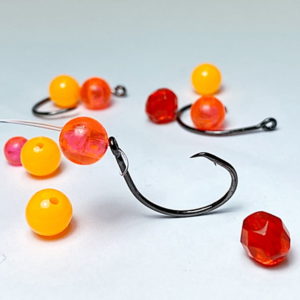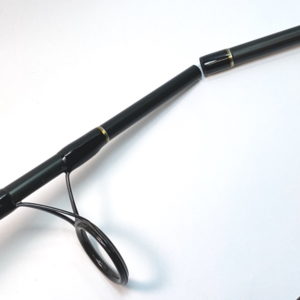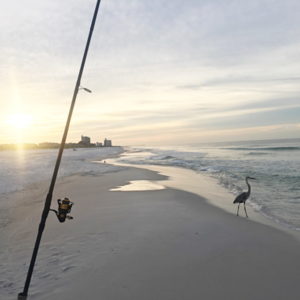
Pensacola Beach is an amazing fishery, offering loads of different species that you can catch right from the beach. Just to name a few, you’ll have a great chance at red drum, pompano, whiting, Spanish mackerel, and speckled trout.
In addition to the more desirable species listed above, you’ll also likely catch sharks, bluefish, black drum, ladyfish, blue runners, stingrays, and catfish, among others. For a more complete list check out all the species listed below.
How edible each of them are is simply a matter of opinion. I assigned a food quality rating to each of them based on my personal experience and otherwise general consensus. Take it for what it’s worth.
1. Florida Pompano
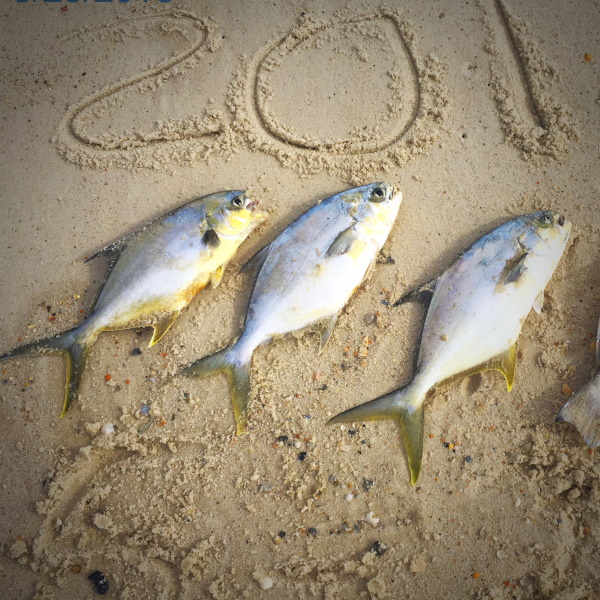
The undisputed #1 target species when fishing from a beach in Pensacola is the Florida Pompano. While this fish is more plentiful in spring and fall, it can be caught all throughout the year. This is my favorite food fish of any that I have tried.
Use 2 hook pompano rigs with small pieces of fresh dead shrimp or medium sized sand fleas. Use shrimp so fresh that you would eat it yourself. Fresh shrimp can be purchased from a bait shop or even from a grocery store. Just don’t use frozen shrimp!
I like to add a small piece of Fish Bites or Fish Gum to the hook after baiting it with shrimp or sand fleas. This provides a little color to the presentation, as well as ensuring that you have extra bait on the hook in case bait stealers peck off your natural bait.
The best all around hook you can use is a 1/0 circle hook. Tie on a 1-3 ounce pyramid sinker and cast your setup out into the first trough off the beach. If the sun is bright overhead you may have to get your bait out past the first sandbar to reach them.
Food Quality: A+
This is the best food quality fish that I have ever had.
2. Whiting
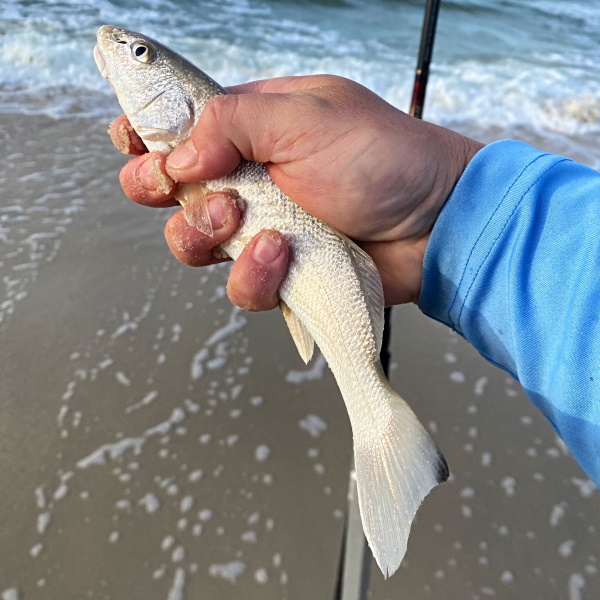
Whiting, or “kingfish”, are perhaps the most common fish you can encounter from the shores of Pensacola Beach. However, unless you use fairly small hooks and small baits, you may never even know that they are there. That would be a shame as these fish make excellent table fare.
Use #2, #1 or 1/0 circle hooks with small pieces of peeled shrimp to load the cooler with whiting. Cast your offering both close and far to find where they are holding. Don’t be surprised if you find them 10 feet off the sand.
Whiting Food Quality: A
A little small, on average, but worth the extra work for some tasty filets.
3. Spanish Mackerel

For me, when they are around, Spanish mackerel are a great “target of opportunity”. Meaning, I’m usually never headed to the beach to specifically pursue them. Instead, I keep a spoon or some other heavy lure tied on to an extra pole so that I can fire it out to a passing school if it comes within reach.
In the the warm months you’ll often spot schools of Spanish busting the surface along the Pensacola beaches. When they pass by, you’ll want to try to hook a few before the school moves beyond your reach. Spanish mackerel are loads of fun to catch from the beach, and many folks love to eat them when they are fresh.
Spanish Food Quality: B
A darker richer filet than many other species listed here. Good fried or smoked.
4. Red Drum
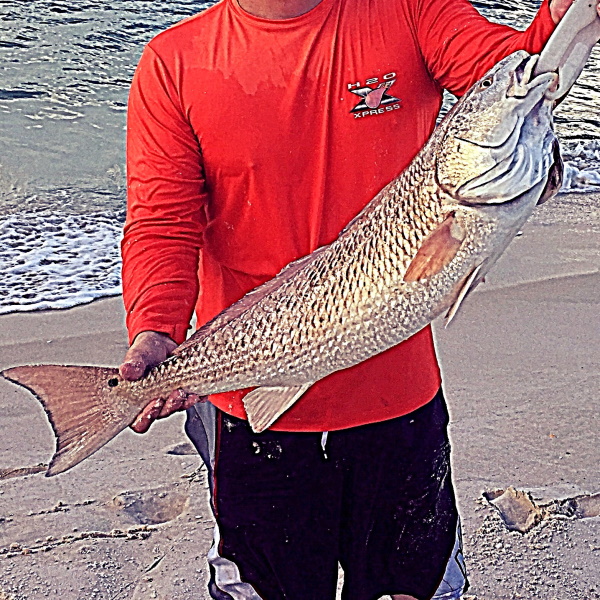
Red drum, or redfish, are one of the most prized Pensacola Beach species. Slot reds are great for the table and the larger bulls are tons of fun to reel in. When I’m bottom fishing for pompano and whiting, I’ll often toss out an extra bigger bait in hopes of tangling with a bull red.
For more info on how to specifically target redfish from the Pensacola beaches, check out my article about that here – How To Catch Bull Reds From Shore
Redfish Food Quality: A
Smaller slot reds are great eating. Trim away any red flesh before cooking and especially before freezing. Larger bull reds should be released.
5. Speckled Trout

Spotted sea trout, or speckled trout, are another great eating option that can be caught from the surf. While they are not always the most consistent bite from the beach, they are worth pursuing in the spring and fall.
If there are pods of bait fish around you have a chance at catching specks. Focus your efforts around cuts in the sandbars where they hang out to ambush their prey. Well, actually that’s good advice for most of the species on this list. Learning to locate these rip current areas is well worth your time and will increase your surf fishing success rate.
This post will give you more guidance on how to pursue this Pensacola favorite. How To Catch Speckled Trout
Speckled Trout Food Quality: A
6. Black Drum
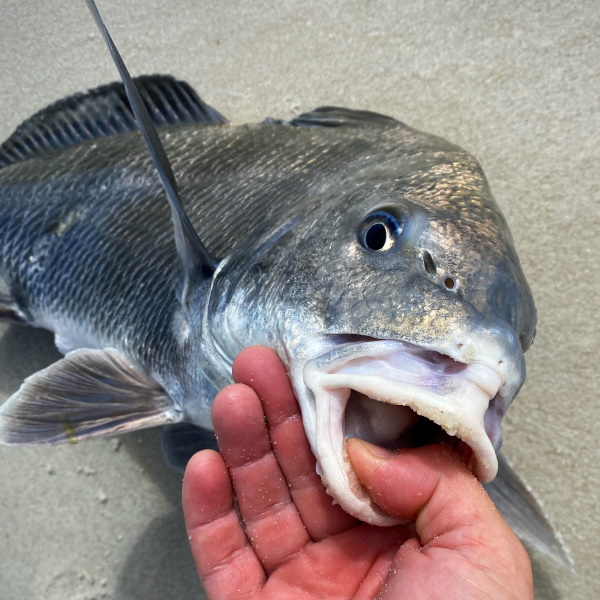
Black drum are one of your best bets at catching a huge fish from shore in Pensacola. While you won’t be specifically targeting this species, it is one that you could certainly encounter.
Even a giant black drum will hit a relatively small piece of bait, so you never know when you might hook up to a “big ugly” in the surf.
The most common time of year to cross paths with a black drum on the beach is during the colder months and early spring. For more info on how to find and wrestle a black drum check this post out. How To Catch Black Drum
Black Drum Food Quality: B
Smaller black drum with visible vertical bars are pretty good to eat, but perhaps not quite as good as redfish. Larger ones should definitely be released, as they aren’t all that great when it comes to food value.
7. Sharks
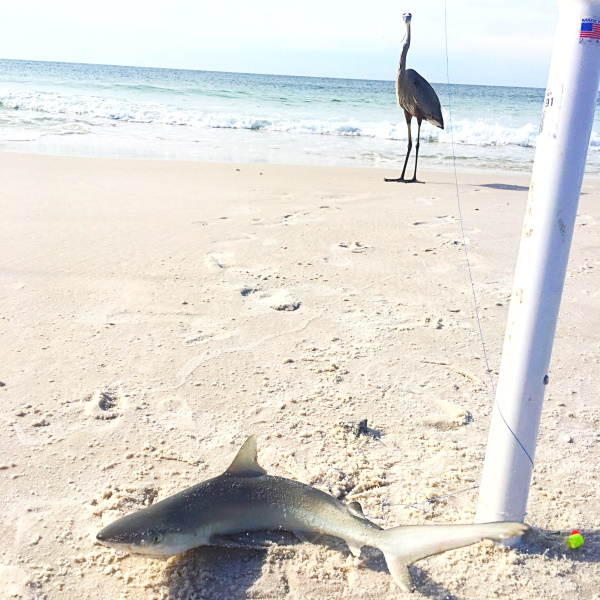
At times little sharks will invade the surf and you’ll catch plenty. Most of the ones you’ll catch will be a byproduct of bottom fishing for pompano and whiting. These will be small enough that you can safely handle them by wrapping your hand around them much like you would a catfish.
When it comes to larger sharks, unless you are specifically targeting them, they will usually cut the line without you so much as getting a glimpse of them. To catch larger sharks you’ll need to up your leader size to something more substantial.
Once a shark gets over about 3 feet long they become strong fighters, and are loads of fun to play with. Check out my article here on how to specifically target sharks from shore, if that’s something you are interested in. How To Catch Sharks From Shore
Shark Food Quality: B-
Blacktip sharks are commonly caught and are pretty good table fare. There are other decent eating species that you might encounter as well. However, you need to read up on shark regulations, as certain species are highly protected.
8. Ladyfish
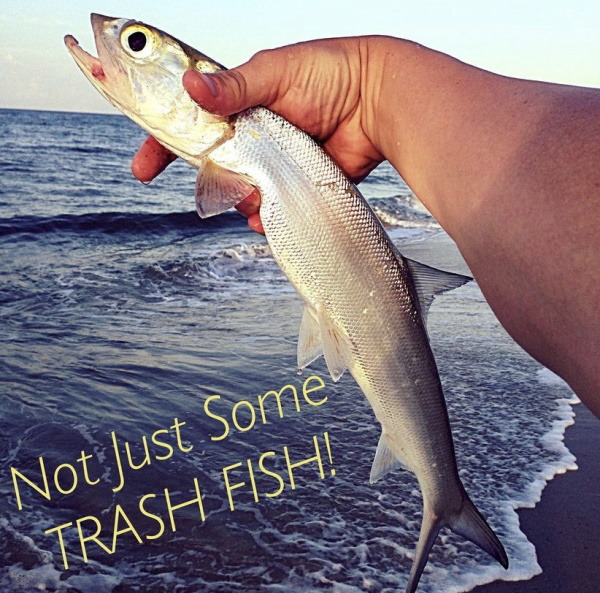
Ladyfish are a very prevalent species in Pensacola. While they are mostly considered a trash fish that’s a nuisance more than anything, they are truly fun to catch.
Nicknamed the “baby tarpon”, ladyfish will often jump out of the water when hooked, and they fight hard. Add in the fact that they have teeth and you may find yourself getting cut off. If so, you might have to tie on some 30 lb. mono leader material to protect from cutoffs.
Ladyfish are a fun species for beginners and kids to cut their teeth on. They also make really good cut bait for larger species, so you might want to keep a couple to use for bull red or shark bait.
For more info on catching ladyfish, check out my post about that here. How To Catch Ladyfish
Ladyfish Food Quality: D-
Mushy and bony. With proper preparation they are edible, but too much trouble for my taste. Better used as cut bait.
9. Bluefish

While bluefish don’t generally get that big in the Pensacola area, they are still tons of fun to catch. Blues are an aggressive schooling fish that fight really hard. If you catch one, rest assured there are a lot more out there.
Bluefish are predominately daytime sight feeders. Use fast moving shiny lures, such as silver spoons, to entice a strike. Topwater lures also work really well.
You’ll want to tie on a short piece of leader stronger than your main line. Otherwise, you may need to kiss your expensive lures goodbye. Blues have very sharp teeth! In fact, you need to take care to avoid these teeth when unhooking them.
For more info on how to target bluefish, check that out here. How To Catch Bluefish From The Beach
Bluefish Food Quality: B-
The smaller bluefish you will likely encounter in Pensacola are actually pretty good to eat. However, special care must be taken to have a good tasting filet. Bleed them, chill immediately and eat them fresh. Otherwise, not great.
10. Hardhead Catfish

If you come from the freshwater world, you might be surprised to learn that the ocean is also loaded with catfish.
When the water warms, and especially when it’s murky, you may run into a hot catfish bite. When bottom fishing, sometimes you may not be able to hook anything except hardhead catfish from your chosen beach. They can be a real nuisance, as they don’t get very big and are not very good to eat. If you are having fun reeling them in, then have at it. Otherwise, you can swap to a synthetic bait, such as Fish Bites, to slow them down a little bit.
If you stick with it, sometimes catfish will eventually move on out of an area and let you get back to some real fishing. If they are especially thick and persistent you may be best served to pack up and drive down the road to a different stretch of beach.
Beware that a saltwater catfish’s spines are very sharp and very toxic. Getting stuck is quite painful, so handle them with care. To be honest, it’s best to use pliers and a de-hooker when dealing with any saltwater catfish.
Hardhead Food Quality: D
11. Gafftopsail Catfish
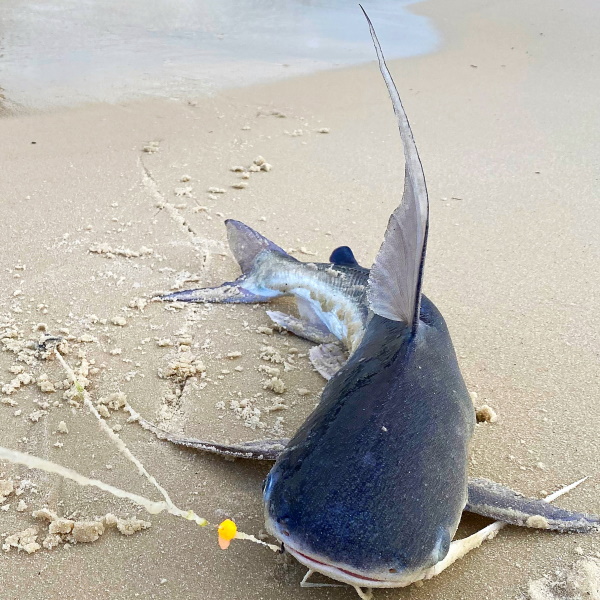
Almost a polar opposite to the dreaded hardhead catfish is the gafftopsail catfish, also referred to as a “sail cat” or simply a “gafftop”. Unlike hardheads, sail cats are less common, grow to a larger size, fight harder, and are actually good table-fare. They even look cooler with their long sail like dorsal fin. To be honest, I have never kept one to eat, but many people do. They are certainly not the nuisance that hardheads are. Be careful when handling, as the spines are dangerous, just as they are with hardheads.
Gafftop Food Quality: B
12. Blue Runners

Occasionally the surf is loaded with blue runners, commonly referred to as hard tails. They don’t get very big, but they are hard fighters for their size. I sometimes keep them for shark bait.
Blue Runner Food Quality: C
With proper care, blue runners are a decent enough fish to eat. You need to bleed them when they are alive, and then cut out the blood line before cooking them. Most of the ones I catch in Pensacola are on the smaller side, so I occasionally keep them for bait.
13. Flounder
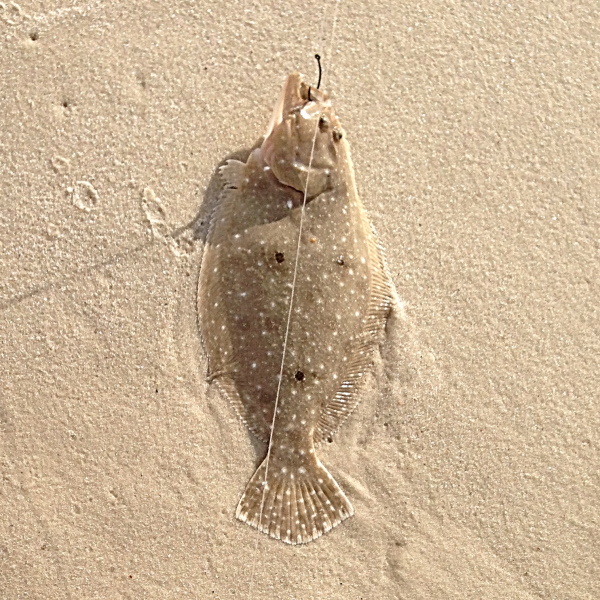
Of course flounder are a super desirable species, but I don’t catch too many when surf fishing unless I’m fishing near an inlet. They will be most commonly found laying near some type of cover near the inlets. Sometimes you’ll get a welcome surprise in the surf, but I wouldn’t count on it. Unless you are fishing inshore and not on the beach, you’d be better served chasing other species from this list.
Flounder Food Quality: A
15. Stingrays
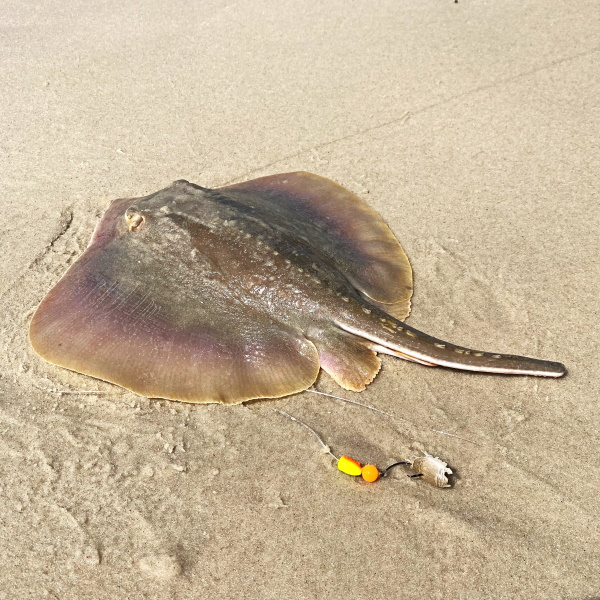
Stingrays are hit and miss for me. There will be times when they will be commonly caught from Pensacola beaches. It just depends on when and where you go, and what kind of bait you use. One time I was fishing with pieces of frozen cigar minnows near the tip of Fort Pickens, and I couldn’t keep them off the hook. Other times I’ll go quite a stretch before I catch one. They are a cool fish to catch if you’ve never caught one. I know my son was very excited to catch his first stingray from the beach. Large ones pull very hard.
Stingrays are another species that I’ll keep for shark bait, but otherwise have no interest in. Just be careful when unhooking them if you catch one. You can find out how to unhook them without getting stung by going here. How To Unhook A Stingray
Stingray Food Quality: C
Decent enough to eat, but too much trouble to deal with in my opinion. Much better options out there.
Other Species
There are, of course, many other fish you may run across when fishing from the beaches in Pensacola. Here’s another list of likely species you’ll eventually encounter if you fish long enough.
- Jack Crevalle
- Croaker
- Remora
- Pinfish
- Cownose Rays
- Spadefish
- Permit
- Mangrove Snapper
- King Mackerel
- Bonito
Conclusion
The full list of species that you can catch from Pensacola Beach almost seems endless. What you really need to know is that you’ll generally want to specifically target pompano, whiting, redfish, speckled trout, Spanish mackerel or bluefish. I have comprehensive articles about how to target all of those species on my site.
Besides the ones listed above, there are others that you’ll need to be very careful handling, such as catfish, stingrays, sharks and anything else you may notice that has gnarly teeth.
You’ll learn that, at times, it will be nearly impossible to avoid catfish, blue runners, ladyfish, or some other “trash” species roaming the surf. But hey, it’s better than catching nothing. I linked to a few other helpful posts below that you might find useful.
How To Catch Pompano
How To Catch Whiting
How To Catch Spanish Mackerel
Good luck out there!
Augustus Clay

